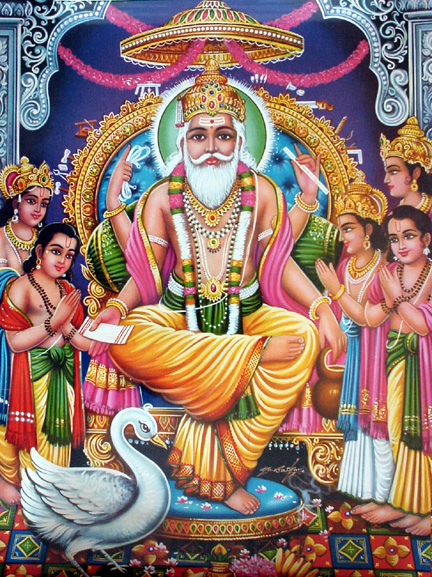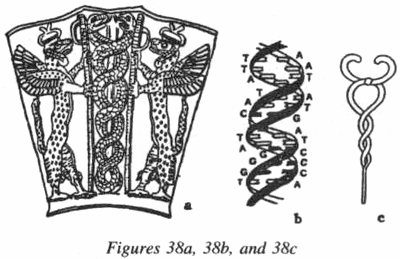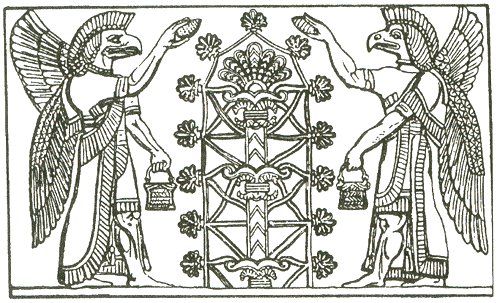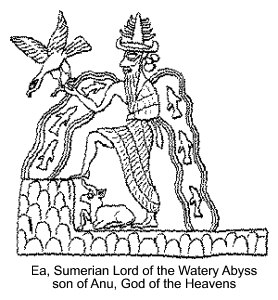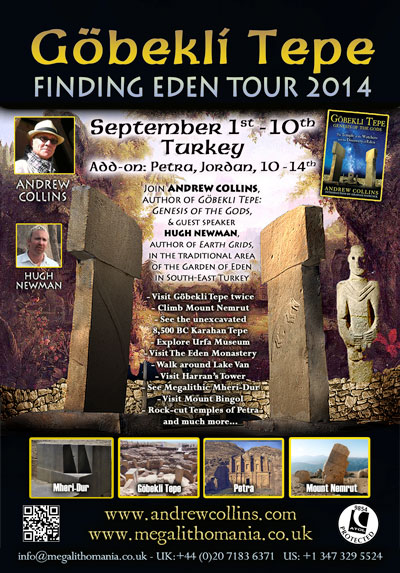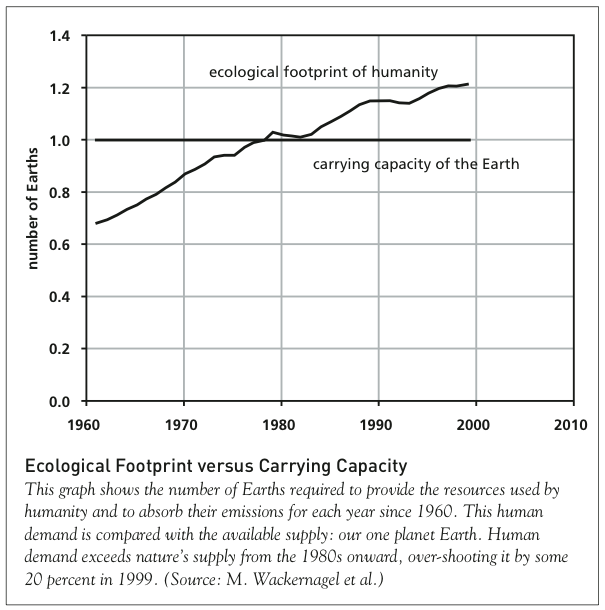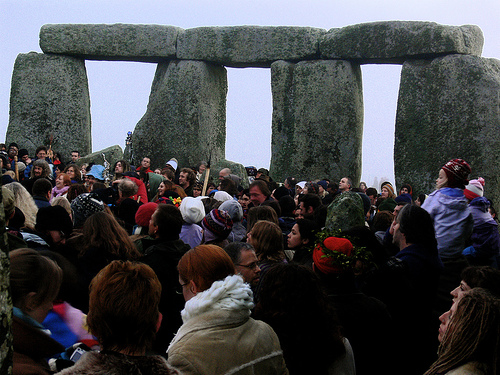![]()
Viswakarma
Tvaṣṭṛ
In Vedic religion, Tvaṣṭṛ is the first born creator of the universe. The term, also transliterated as Tvaṣṭr, nominative Tvaṣṭā, is the heavenly builder, the maker of divine implements, especially Indra’s Vajra and the guardian of Soma. Tvaṣṭṛ is mentioned 65 times in the Ṛgveda and is the former of the bodies of men and animals,’ and invoked when desiring offspring, called garbha-pati or the lord of the womb.
Tvaṣṭṛ is sometimes associated or identified with similar deities, such as Savitṛ, Prajāpatī, Viśvakarman and Puṣan. He is the father of Saranyṇ, who twice bears twins to Vivasvat (RV 8.26.21), Yama and Yami, also identified as the first humans. He is also the father of Viśvarūpa or Triśiras who was killed by Indra, in revenge Tvaṣṭṛ created Vrtra a fearsome dragon. Surprisingly he is also inferred to as Indra’s father.
Tvaṣṭṛ is a solar deity in the epic of Mahābhārata and the Harivaṃśa. He is mentioned as the son of Kāśyapa and Aditi, and is said to have made the three worlds with pieces of the Sun god Surya. The sr name of south Indian goldsmiths Tattar is probably derived from the term Tvoshtar.
Viswakarma
Tvaṣṭṛ is the visible form of creativity emerged from the navel of the invisible Viswakarma (“all-accomplishing, maker of all,” “all doer”), the personified Omnipotence and the abstract form of the creator God according to the Rigveda.
In later puranas Vishwakarma is sometimes identified with vedic Tvastar. Silpi Vishwakarma is the designer of all the flying chariots of the gods, and all their weapons and divine attributes. Vishwakarma/Tvostar is also credited with creating the missiles used in the mythological era, including the Vajra, the sacred weapon of Lord Indra, from the bones of sage Dadhichi. He is regarded as the supreme worker, the very essence of excellence and quality in craftsmanship.
Viswakarma is the presiding deity of all craftsmen and architects. He is believed to be the “Principal Architect of the Universe “, and the root concept of the later Upanishadic Brahman/Purusha, a complex concept whose meaning evolved in Vedic and Upanishadic times. Depending on source and historical timeline, it means the cosmic man or it means Self, Consciousness, and Universal principle.
Vishwakarma is visualized as Ultimate reality (later developed as Brahman) in the Rig Veda, from whose navel all visible things Hiranyagarbha emanate. The same imagery is seen in Yajurveda purusha sukta, in which the divine smith Tvastar emerging from Vishwakarma. In the later puranic period this concept paved the way to the imagery of Padmanabha and Sadasiva.
Hindu scriptures describe many of Vishwakarma’s architectural accomplishments. Through the four yugas (aeons of Hindu mythology), he had built several towns and palaces for the gods. Among them were, in chronological order, Svarga (Heaven) in the Satya Yuga, Lanka in the Treta Yuga, and Dwarka (Krishna’s capital) in the Dwapara Yuga.
Viswakarma is also supposed to have built Dwarka overnight. During the time of the Mahabharata, Lord Krishna is said to have lived in Dwarka, and made it his “Karma Bhumi” (center of operation). This land now located in today’s Gujarat has become a well known pilgrimage for the Hindus.
Since Vishwakarma is the divine engineer of the world. As a mark of reverence, he is not only worshiped by the engineering and architectural community but also by all professionals. It is customary for craftsmen to worship their tools in his name.
Silpy Vishwakarma is attributed a putative birthday by the Hindu religion. The more philosophical minded argue that it is impossible for the original Creator of everything to be born on a particular day.
In Rigveda he is described as Swayambhu so it is a contradiction in terms since that presupposes another creator for Vishwakarma. The Vishwakarma Puja is celebrated in all parts of India, especially in Bihar, Assam, Odisha, West Bengal, Rajasthan, Uttarakhand, Dehradun and Manipur.
Vishvakarma [ God ] created five prajapathies – from his five faces such as Sadyojāta,Vāmadeva, Aghora,Tatpuruṣha,Īsāna. They are Manu, Maya, Twosta, Silpy, Viswajna and their respective Rishis.
Vishwakarma Day
Vishwakarma Day is celebrated to worship Vishwakarma, a Hindu god. Vishvakarma was the divine architect, and one of the fourteen precious things born of the Samudra manthan. He constructed the holy city of Dwarka where Lord Krishna ruled, the Maya Sabha of the Pandavas, and was the creator of many fabulous weapons for the gods. He is also called the divine carpenter, is mentioned in the Rig Veda, and is credited with Sthapatya Veda, the science of mechanics and architecture.
It is celebrated on September 16 or 17 (in some states in India, like Karnataka, West Bengal, Bihar, Jharkhand, Orrisa, and Tripura). The festival is observed primarily in factories and industrial areas, often on the shop floor. Vishwakarma is known to be the divine engineer since the Puranic age. As a mark of reverence he is worshipped not only by the engineering and architectural community, but also by all professionals.
Artisans, craftsmen, mechanics, smiths, welders, industrial workers, factory workers, and workers of all kinds worship Lord Vishwakarma on this day and pray for a better future, safe working conditions, and above all success in their respective fields. Workers also pray for the smooth functioning of various machines. It is customary for craftsmen to worship their tools in His name. Workers refrain from using the tools while doing so.
Special statues and pictures of Lord Vishwakarma are normally installed in every workplace and factory. All workers gather in one common place and perform the puja. In many factories owner and employees worship vishwakarma ji for the good working of their works.
As per Indian mythology Vishwakarma puja (reverence) is also celebrated a day after Diwali, along with Govardhan Puja.
The Vishwakarma (or Visvakarma) community refes to themselves as the Viswabrahmin, and are sometimes described as a caste. The community comprises five sub-groups – carpenters, blacksmiths, bell metalworkers, goldsmiths and stonemasons – who believe that they are descendants of Vishwakarma, a Hindu deity. They worship various forms of this deity and follow five Vedas: Rigveda, Yajurveda, Samaveda, Atharvaveda, and Pranava Veda.
Rathakāra/Takṣā
Tvaṣṭṛ is also referred to as Rathakāra or the chariot maker and sometimes as Takṣā in Ṛgveda. The term Tvaṣṭṛ is mentioned in the Mitanni treaty, which establishes him as a Proto-Indo-Iranian divinity.
As per Ṛgveda Tvaṣṭr known as Rathakāra belongs to clan of the Bhṛgus. Similarly, as mentioned in the epic Mahābhārata, Tvaṣṭr or the Rathakāra is Śukrācārya’s son, Śukrācārya (the mentor of the demons) is Bhṛgu’s grandson and Vāruṇibhṛgu’s son.
Brahman/Purusha
In early Vedas, Purusa meant a cosmic man whose sacrifice by the gods created all life. This was one of many creation theories discussed in the Vedas. In Yajurveda purusha suktha and in the 10th mandala of the Rigveda the character and attributes of Tvaṣṭṛ are merged with the concept of Hiranyagharbha/Prajapathy or Brahma/Purusha.
In Upanishads, Purusa concept no longer meant a being or cosmic man. The meaning evolved to an abstract essence of Self, Spirit and the Universal Principle that is eternal, indestructible, without form and all pervasive.
The Purusa concept is explained with the concept of Prakrti in the Upanishads. The universe is envisioned, in these ancient Sanskrit texts, as a combination of perceivable material reality and non-perceivable, non-material laws and principles of nature.
Material reality, or Prakrti, is everything that has changed, can change and is subject to cause and effect. Purusa is the Universal principle that is unchanging, uncaused but is present everywhere and the reason why Prakrti changes, evolves all the time and why there is cause and effect. Purusa is what connects everything and everyone, according to various schools of Hinduism.
Ymir
![]()
![]()
![]()
Purusa parallels Norse Ymir (Ymir, Aurgelmir, Brimir, or Bláinn), a primeval being born of primordial elemental poison and the ancestor of all jötnar, with the myth’s origin in Proto-Indo-European religion.
Ymir is attested in the Poetic Edda, compiled in the 13th century from earlier traditional material, in the Prose Edda, written by Snorri Sturluson in the 13th century, and in the poetry of skalds.
Taken together, several stanzas from four poems collected in the Poetic Edda refer to Ymir as a primeval being who was born from venom that dripped from the icy rivers Élivágar and lived in the grassless void of Ginnungagap.
Ymir birthed a male and female from the pits of his arms, and his legs together begat a six-headed being. The gods Odin, Vili, and Vé fashioned the Earth (elsewhere personified as a goddess; Jörð) from his flesh, from his blood the ocean, from his bones the hills, from his hair the trees, from his brains the clouds, from his skull the heavens, and from his eyebrows the middle realm in which mankind lives, Midgard. In addition, one stanza relates that the dwarfs were given life by the gods from Ymir’s flesh and blood (or the Earth and sea).
In the Prose Edda, a narrative is provided that draws from, adds to, and differs from the accounts in the Poetic Edda. According to the Prose Edda, after Ymir was formed from the elemental drops, so too was Auðumbla, a primeval cow, whose milk Ymir fed from. The Prose Edda states that three gods killed Ymir; the brothers Odin, Vili, and Vé, and details that, upon Ymir’s death, his blood caused an immense flood.
Scholars have debated as to what extent Snorri’s account of Ymir is an attempt to synthesize a coherent narrative for the purpose of the Prose Edda and to what extent Snorri drew from traditional material outside of the corpus that he cites.
The primordial being
By way of historical linguistics and comparative mythology, scholars have linked Ymir to other primordial, sometimes hermaphroditic or twin beings in other Indo-European mythologies and have reconstructed elements of a Proto-Indo-European cosmological dissection.
Citing Ymir as a prime example, scholars J. P. Mallory and Douglas Q. Adams comment that “the [Proto-Indo-European] cosmogonic myth is centered on the dismemberment of a divine being—either anthropomorphic or bovine—and the creation of the universe out of its various elements”.
Further examples cited include the climactic ending of the Old Irish Táin Bó Cúailnge where a bull is dissected that makes up the Irish geography, and apparently Christianized forms of the myth found in the Old Russian Poem of the Dove King, the Frisian Frisian Code of Emsig, and Irish manuscript BM MS 4783, folio 7a.
Other examples given include Ovid’s 1st century BC to 1st century AD Latin Metamorphoses description of the god Atlas’s beard and hair becoming forests, his bones becoming stone, his hands mountain ridges, and so forth; the 9th century AD Middle Persian Škend Gumānīg Wizār, wherein the malevolent being Kūnī’s skin becomes the sky, from his flesh comes the earth, his bones the mountains, and from his hair comes plants; and the 10th century BC Old Indic Purusha sukta from the Rig Veda, which describes how the primeval man Purusha was dissected; from his eye comes the sun, from his mouth fire, from his breath wind, from his feet the earth, and so on.
Among surviving sources, Adams and Mallory summarize that “the most frequent correlations, or better, derivations, are the following: Flesh = Earth, Bone = Stone, Blood = Water (the sea, etc.), Eyes = Sun, Mind = Moon, Brain = Cloud, Head = Heaven, Breath = Wind”.
Adams and Mallory write that “In both cosmogonic myth and the foundation element of it, one of the central aspects is the notion of sacrifice (of a brother, giant, bovine, etc.). The relationship between sacrifice and cosmogony was not solely that of a primordial event but the entire act of sacrifice among the Indo-Europeans might be seen as a re-creation of the universe where elements were being continuously recycled. [ . . . ] Sacrifice thus represents a creative re-enactment of the initial cosmic dismemberment of a victim and it helps return the material stuff to the world”.
Tuisto
According to Tacitus’s Germania (98 CE), Tuisto (or Tuisco) is the divine ancestor of the Germanic peoples. The figure remains the subject of some scholarly discussion, largely focused upon etymological connections and comparisons to figures in later (particularly Norse) Germanic mythology. In the larger Indo-European pantheon, Tuisto is equated to the Vedic Tvastar.
The Germania manuscript corpus contains two primary variant readings of the name. The most frequently occurring, “Tuisto”, is commonly connected to the Proto-Germanic root *tvai- “two” and its derivative *tvis- “twice” or “doubled”, thus giving Tuisto the core meaning “double”.
Any assumption of a gender inference is entirely conjectural, as the tvia/tvis roots are also the roots of any number of other concepts/words in the Germanic languages. Take for instance the Germanic “twist”, which, in all but the English has the primary meaning of “dispute/conflict”.
The second variant of the name, occurring originally in manuscript E, reads “Tuisco”. One proposed etymology for this variant reconstructs a Proto-Germanic *tiwisko and connects this with Proto-Germanic *Tiwaz, giving the meaning “son of Tiu”. This interpretation would thus make Tuisco the son of the sky-god (Proto-Indo-European *Dyeus) and the earth-goddess.
In the 1st century AD, Roman historian Tacitus writes in his ethnographic work Germania that the Germanic peoples sing songs about a primeval god who was born of the Earth named Tuisto, and that he was the progenitor of the Germanic peoples. Tuisto is the Latinized form of a Proto-Germanic theonym that is a matter of some debate.
Tacitus relates that “ancient songs” (Latin carminibus antiquis) of the Germanic peoples celebrated Tuisto as “a god, born of the earth” (deum terra editum'; see Autochthon (ancient Greece)). These songs further attributed to him a son, Mannus, who in turn had three sons, the offspring of whom were referred to as Ingaevones, Herminones and Istaevones, living near the Ocean (proximi Oceano), in the interior (medii), and the remaining parts (ceteri) of the geographical region of Germania, respectively.
Tacitus’s report falls squarely within the ethnographic tradition of the classical world, which often fused anthropogony, ethnogony, and theogony together into a synthetic whole. The succession of father-son-three sons parallels occurs in both Germanic and non-Germanic Indo-European areas. The essential characteristics of the myth have been theorized as ultimately originating in Proto-Indo-European society around 2,000 BCE.
According to Rives (1999), the fact that the ancient Germanic peoples claimed descent from an earth-born god was used by Tacitus to support his contention that they were an indigenous population: the Latin word indigena was often used in the same sense as the Greek autochthonos, meaning literally ‘[born from] the earth itself’ (from χθών – chthōn “earth”).
Lindauer (1975) notes that, although this claim is to be judged as one made out of simple ignorance of the facts on the part of Tacitus, he was not entirely wrong, as he made the judgement based on a comparison with the relatively turbulent Mediterranean region of his day.
The order in which one god gives has a son which in turn has three famous sons has a resemblance to how Búri has the son Borr who in turn has three sons: Odin, Vili and Vé. Same tradition occurs with the Slavs and their expansion, in the legend of Lech, Čech and Rus.
In 1498, a monk named Annio da Viterbo published fragments known as “Pseudo-Berossus”, now considered a forgery, claiming that Babylonian records had shown that Tuiscon or Tuisto, the fourth son of Noah, had been the first ruler of Scythia and Germany following the dispersion of peoples, with him being succeeded by his son Mannus as the second king. Later historians (e.g. Johannes Aventinus) managed to furnish numerous further details, including the assertion by James Anderson that this Tuiscon was in fact none other than the biblical Ashkenaz, son of Gomer.
Tuisto/Ymir
By way of historical linguistics and comparative mythology, scholars have linked Ymir to Tuisto, the Proto-Germanic being attested by Tacitus in his 1st century AD work Germania and have identified Ymir as an echo of a primordial being reconstructed in Proto-Indo-European mythology.
Connections have been proposed between the 1st century figure of Tuisto and the hermaphroditic primeval being Ymir in later Norse mythology, attested in 13th century sources, based upon etymological and functional similarity. Meyer (1907) sees the connection as so strong, that he considers the two to be identical.
Lindow (2001), while mindful of the possible semantic connection between Tuisto and Ymir, notes an essential functional difference: while Ymir is portrayed as an “essentially … negative figure” – Tuisto is described as being “celebrated” (celebrant) by the early Germanic peoples in song, with Tacitus reporting nothing negative about Tuisto.
Jacob (2005) attempts to establish a genealogical relationship between Tuisto and Ymir based on etymology and a comparison with (post-) Vedic Indian mythology: as Tvastr, through his daughter Saranyū and her husband Vivaswān, is said to have been the grandfather of the twins Yama and Yami, so Jacob argues that the Germanic Tuisto (assuming a connection with Tvastr) must originally have been the grandfather of Ymir (cognate to Yama). Incidentally, Indian mythology also places Manu (cognate to Germanic Mannus), the Vedic progenitor of mankind, as a son of Vivaswān, thus making him the brother of Yama/Ymir.
Dyēus
Dyēus (also *Dyēus ph2ter, alternatively spelled dyēws) is believed to have been chief deity in the religious traditions of the prehistoric Proto-Indo-European societies. Part of a larger pantheon, he was the god of the daylight sky, and his position may have mirrored the position of the patriarch or monarch in society. This deity is not directly attested; rather scholars have reconstructed this deity from the languages and cultures of later Indo-European peoples.
Rooted in the related but distinct Indo-European word *deiwos is the Latin word for deity, deus. The Latin word is also continued in English divine, “deity”, and the original Germanic word remains visible in “Tuesday” (“Day of Tīwaz”) and Old Norse tívar, which may be continued in the toponym Tiveden (“Wood of the Gods”, or of Týr). Estonian Tharapita bears similarity to Dyaus Pita in name, although it has been interpreted as being related to the god Thor.
As the pantheons of the individual mythologies related to the Proto-Indo-European religion evolved, attributes of Dyeus were sometimes redistributed to other deities. In Greek and Roman mythology, Dyeus remained the chief god, but in Vedic mythology, the etymological continuant of Dyeus became a very abstract god, and his original attributes, and his dominance over other gods, were transferred to gods such as Agni or Indra.
Dyēus’s name also likely means “the daytime sky”. In Sanskrit as div- (nominative singular dyāus with vrddhi). Its singular means “the sky” and its plural means “days”. Its accusative form *dyēm became Latin diem “day”, which later gave rise to a new nominative diēs. The original nominative survives as diūs in a few fixed expressions.
Finnish taivas Estonian taevas, Livonian tōvaz etc. (from Proto-Finnic *taivas), meaning “heaven” or “sky,” are likely rooted in the Indo-European word. The neighboring Baltic Dievas or Germanic Tiwaz are possible sources, but the Indo-Iranian *daivas accords better in both form and meaning. Similar origin has been proposed for the word family represented by Finnish toivoa “to hope” (originally “to pray from gods”).
Tinia (also Tin, Tinh, Tins or Tina), the main Etruscan god, the ruler of the sky, is similar to the Greek Zeus and Roman Jupiter. He is the husband of Uni, the main goddess of the Etruscan pantheon, and protector of Perugia. She is the same as the Roman Juno, and the Greek Hera, in Greek mythology the goddess of marriage, life and love, and one of the Twelve Olympians.
Together Tinia and Uni begot Hercle, a divine hero in Greek mythology – the greatest of the Greek heroes. Tinia, Uni and Menrva was one of the three main Etruscan Gods. Ani was also a god of the sky who lived in the highest level of the heavens. His name may be linked to the Roman god Janus.
Hindu mystics knew from their experience, that verbal descriptions of the Supreme Reality can be Incomplete and hence resorted to Mythology to convey the feeling of their communion with god. Vedic Seers composed hymns eulogizing the sentient beings guarding all Natural and Supernatural phenomena and called them Devas that stems from the Sanskrit root ‘Div’meaning the ‘Shining One’.
The derived term ‘Deus’ or ‘Dios’ from the same root, is still used to refer to God in modern European languages and even in the translations of the New Testament of Bible. The oldest texts detail 33 principle Devas who were the guardians of Nature and Cosmic Creation.
They are the 12 Adityas or Solar gods, including Indra, Surya, Mitra and Varun, the 11 Rudras (the Manifestations of Lord Shiva), the 8 Vasus or Elemental gods, such as Vayu, Agni, Antariksh and Dyaus, the Sky God, Prajapati Brahma, and Shri Hari Vishnu.
The ancients especially venerated the Adityas and Vedas are full of hymns dedicated to Indra, Agni, Surya, Varun and the like. The 12 Adityas correspond to the 12 Solar months and represent different attributes of social life. Interestingly, these 12 Adityas were adopted into Chinese and Japanese Buddhism as guardians of the monasteries covering the four main directions, four semi-directions, above, below and the Sun and Moon.
Deva is a Sanskrit term meaning god, deity, or celestial being. It is rendered as Ten 天 in Japan (天 literally means Heaven or Celestial). The Deva are deities borrowed from Hindu mythology and adopted into Chinese and Japanese Buddhism as guardians of the monasteries of Esoteric Buddhism. They appear frequently in Japanese mandala. Among the 12, Bonten (Brahma) and Taishakuten (Indra) serve in the highest position. Also known as the Twelve Gods Protecting the World.
About the sumerian term AN/DINGIR
Manu and Yemo
Analysis of different Indo-European tales indicates the Proto-Indo-Europeans believed there were two progenitors of mankind: *Manu- (“Man”; Indic Manu; Germanic Mannus) and *Yemo- (“Twin”; Indic Yama; Germanic Ymir), his twin brother. Cognates of this set of twins appear as the first mortals, or the first gods to die, sometimes becoming the ancestors of everyone and/or king(s) of the dead.
The Germanic languages have information about both Ymir and Mannus (cognates of *Yemo- and *Manu- respectively), but they never appear in the same myth, rather they appear only in myths widely separated in both time and circumstances.
Mannus
Mannus, according to the Roman writer Tacitus, was a figure in the creation myths of the Germanic tribes. Tacitus wrote that Mannus was the son of Tuisto and the progenitor of the three Germanic tribes Ingaevones, Herminones and Istvaeones. Tacitus is the only source of these myths.
In discussing the German tribes Tacitus wrote: In ancient lays, their only type of historical tradition, they celebrate Tuisto, a god brought forth from the earth. They attribute to him a son, Mannus, the source and founder of their people, and to Mannus three sons, from whose names those nearest the Ocean are called Ingvaeones, those in the middle Herminones, and the rest Istvaeones.
Some people, inasmuch as antiquity gives free rein to speculation, maintain that there were more sons born from the god and hence more tribal designations—Marsi, Gambrivii, Suebi, and Vandilii—and that those names are genuine and ancient.
Mannus again became popular in literature with the 16th century, after works published by Annius de Viterbo and Johannes Aventinus purported to list him as a primeval king over Germany and Sarmatia. In 1845, F. Nork wrote that the names of the three sons of Mannus can be extrapolated as Ingui, Irmin, and Istaev aka Iscio.
A Roman text (dated CE 98) tells that Mannus, the son of Tuisto, was the ancestor of the Germanic people, according to Tacitus, writing in Latin, in Germania 2. We never see this being again, but the name Allemagne is interpreted (perhaps by folk etymology) as “all-men” the name for themselves.
Minos
![]()
![]()
Minotaur
A few scholars like Ralph T. H. Griffith in the 1800s have claimed a connection between Mannus and the names of other ancient founder-kings, such as Minos, a king of Crete, son of Zeus and Europa, of Greek mythology, and Manu, in some Hindu traditions a title accorded to a progenitor of humanity.
Every nine years, Minos made King Aegeus pick seven young boys and seven young girls to be sent to Daedalus’ creation, the labyrinth, to be eaten by the Minotaur. After his death, Minos became a judge of the dead in the underworld. The Minoan civilization of Crete has been named after him by the archaeologist Arthur Evans.
Vaivasvata Manu
Vaivasvata Manu, whose original name was Satyavrata, is the 7th Manu and considered the first king to rule this earth, who saved humanity from the great flood – after being warned of it by the Matsya avatar of Vishnu, who had also advised him to build a giant boat.
The story is mentioned in early Hindu scriptures such as the Satapatha Brahmana, and it has often been compared with the popular traditions of a Great Deluge from other cultures around the world, particularly that of Noah’s Ark. Because Manu was believed to be absolutely honest, he was initially known as Satyavrata (“One with the oath of truth”). Vaivasvata Manu ruled as King Manu. His wife was Sraddha.
According to the Matsya Purana, the Matsya Avatar of Vishnu is believed to have appeared initially as a Shaphari (a small carp), to King Manu (whose original name was Satyavrata), while he washed his hands in a river. This river was supposed to have been flowing down the Malaya Mountains in his land of Dravida (South India).
The little Fish asked the king to save Him, and out of compassion, he put it in a water jar. It kept growing bigger and bigger, until King Manu first put Him in a bigger pitcher, and then deposited Him in a well. When the well also proved insufficient for the ever-growing Fish, the King placed Him in a tank (reservoir), that was two yojanas (16 miles) in height above the surface and on land, as much in length, and a yojana (8 miles) in breadth.
As it grew further King Manu had to put the fish in a river, and when even the river proved insufficient he placed it in the ocean, after which it nearly filled the vast expanse of the great ocean.
It was then that He (Lord Matsya), revealing Himself, informed the King of an all-destructive deluge which would be coming very soon. The King built a huge boat which housed his family, 9 types of seeds, and animals to repopulate the earth, after the deluge would end and the oceans and seas would recede. At the time of deluge, Vishnu appeared as a horned fish and Shesha appeared as a rope, with which Vaivasvata Manu fastened the boat to horn of the fish.
According to the Matsya Purana, his boat was perched after the deluge on the top of the Malaya Mountains. This narrative is to an extent similar to other deluge stories, like those of Ziusudra (also Zi-ud-sura and Zin-Suddu; Hellenized Xisuthros: “found long life” or “life of long days”) of Shuruppak listed in the WB-62 Sumerian king list recension as the last king of Sumer prior to the deluge, Akkadian Atrahasis (“extremely wise”), Utnapishtim (“he found life”), as well as biblical Noah (“rest”).
Near East
![]()
![]()
![]()
Enki (Sumerian: EN.KI(G)) is a god in Sumerian mythology, later known as Ea in Akkadian and Babylonian mythology. He was originally patron god of the city of Eridu, but later the influence of his cult spread throughout Mesopotamia and to the Canaanites, Hittites and Hurrians.
He was accompanied by an attendant Isimud. He was also associated with the planet Mercury in the Sumerian astrological system. His symbols included a goat and a fish, which later combined into a single beast, the goat Capricorn, recognised as the Zodiacal constellation Capricornus.
Enki (Ea in the Akkadian language) were apparently depicted, sometimes, as a man covered with the skin of a fish, and this representation, as likewise the name of his temple E-apsu, “house of the watery deep”, points decidedly to his original character as a god of the waters. Around the excavation of the 18 shrines found on the spot, thousands of carp bones were found, consumed possibly in feasts to the god.
In Sumerian mythology, Nammu (also Namma, spelled ideographically NAMMA = ENGUR) was a primeval goddess, corresponding to Tiamat, who was a creature of salt water, in Babylonian mythology.
Nammu was the Goddess sea (Engur/Abzu) that gave birth to An (heaven) and Ki (earth) and the first gods, representing the Apsu, the fresh water ocean that the Sumerians believed lay beneath the earth, the source of life-giving water and fertility in a country with almost no rainfall. She is not well attested in Sumerian mythology, but may have been of greater importance prehistorically, before Enki took over most of her functions.
Enki was believed to have lived in the abzu since before human beings were created. His wife Damgalnuna, his mother Nammu, his advisor Isimud and a variety of subservient creatures, such as the gatekeeper Lahmu, also lived in the abzu.
The Abzu (Cuneiform: ZU.AB; Sumerian: abzu; Akkadian: apsû) also called engur, (Cuneiform: LAGAB×HAL; Sumerian: engur; Akkadian: engurru) literally, ab=’water’ (or ‘semen’) zu=’to know’ or ‘deep’ was the name for fresh water from underground aquifers that was given a religious fertilizing quality in Sumerian and Akkadian mythology. Lakes, springs, rivers, wells, and other sources of fresh water were thought to draw their water from the abzu.
In the city Eridu, Enki’s temple was known as E2-abzu (house of the cosmic waters) and was located at the edge of a swamp, an abzu. Certain tanks of holy water in Babylonian and Assyrian temple courtyards were also called abzu (apsû). Typical in religious washing, these tanks were similar to the washing pools of Islamic mosques, or the baptismal font in Christian churches.
According to the Neo-Sumerian mythological text Enki and Ninmah, Enki is the son of An and Nammu. Nammu is the goddess who “has given birth to the great gods”. It is she who has the idea of creating mankind, and she goes to wake up Enki, who is asleep in the Apsu, so that he may set the process going. Reay Tannahill in Sex in History (1980) singled out Nammu as the “only female prime mover” in the cosmogonic myths of antiquity.
The Atrahasis-Epos has it that Enlil requested from Nammu/Namma, the Goddess sea (Engur/ Abzu), the creation of humans. And Nammu told him that with the help of Enki (her son) she can create humans in the image of gods. Enki then advises that the gods create a servant of the gods, humankind, out of clay and blood.
In Mesopotamian Religion (Sumerian, Assyrian, Akkadian and Babylonian), Tiamat is a chaos monster, a primordial goddess of the ocean, mating with Abzû (the god of fresh water) to produce younger gods.
It is suggested that there are two parts to the Tiamat mythos, the first in which Tiamat is ‘creatrix’, through a “Sacred marriage” between salt and fresh water, peacefully creating the cosmos through successive generations.
In the second “Chaoskampf” Tiamat is considered the monstrous embodiment of primordial chaos. Although there are no early precedents for it, some sources identify her with images of a sea serpent or dragon.
In the Enûma Elish, the Babylonian epic of creation, she gives birth to the first generation of deities; her husband, Apsu, later makes war upon them and is killed. When she, too, wars upon her husband’s murderers, she is then slain by Ea’s son, the storm-god Marduk. The heavens and the earth are formed from her divided body.
In the Babylonian tale, Enlil’s role is taken by Marduk, Enki’s son, and in the Assyrian version it is Asshur. After dispatching Tiamat with the “arrows of his winds” down her throat and constructing the heavens with the arch of her ribs, Enlil places her tail in the sky as the Milky Way, and her crying eyes become the source of the Tigris and Euphrates.
Kingu, also spelled Qingu, meaning “unskilled laborer,” was a god in Babylonian mythology, and — after the murder of his father Abzu — the consort of the goddess Tiamat, his mother, who wanted to establish him as ruler and leader of all gods before she was slain by Marduk.
Tiamat gave Kingu the 3 Tablets of Destiny, which he wore as a breastplate and which gave him great power. She placed him as the general of her army. However, like Tiamat, Kingu was eventually slain by Marduk.
According to one traditional story, Marduk mixed Kingu’s blood with earth and used the clay to mold the first human beings. Kingu then went to live in the underworld kingdom of Ereshkigal, along with the other deities who had sided with Tiamat. Enûma Elish.
Against Enki’s wish the Gods decide to slay Kingu, and Enki finally consents to use Kingu’s blood to make the first human, with whom Enki always later has a close relationship, the first of the seven sages, seven wise men or “Abgallu” (Ab = water, Gal = great, Lu = Man), also known as Adapa.
Enki assembles a team of divinities to help him, creating a host of “good and princely fashioners”. He tells his motherAdapa, the first man fashioned, later goes and acts as the advisor to the King of Eridu, when in the Sumerian Kinglist, the “Me” of “kingship descends on Eridu”.
Man
The term man (from Proto-Germanic *mannaz or *manwaz “man, person”) is derived from a Proto-Indo-European root *man- (Sanskrit/Avestan manu-, Slavic mǫž “man, male”). The Slavic forms (Russian muzh “man, male” etc.) are derived from a suffixed stem *man-gyo-.
The word developed into Old English man, mann meaning primarily “adult male human” but secondarily capable of designating a person of unspecified gender, “someone, one” or humanity at large (German Mann, Old Norse maðr, Gothic manna “man”).
More restricted English terms for an adult male were wer (cognate: Latin vir; survives as the first element in “werewolf”) and guma (cognate: Latin homo; survives as the second element in “bridegroom”).
However, man in traditional usage refers to the species, to humanity as a whole. Equating the term for the male with the whole species is common in many languages (e.g. French l’Homme). For example, the German equivalent of man is “Mensch” which is male grammatically, but refers to a person in general, of either gender.
*Mannaz or *Manwaz is also the Proto-Germanic reconstructed name of the m-rune ᛗ. Mannaz represents the human race, humanity, the shared human nature within each individual. We are all members of the human family, yet alone in life and in the final journey into death. Mannaz symbolizes creativity, intelligence, forward planning, and speech and implies co-operation between individuals for the common good.
In Hindu mythology, Manu is the name of the traditional progenitor of humankind who survives a deluge and gives mankind laws. The hypothetically reconstructed Proto-Indo-European form *Manus may also have played a role in Proto-Indo-European religion based on this, if there is any connection with the figure of Mannus — reported by the Roman historian Tacitus in ca. AD 70 to be the name of a traditional ancestor of Germans and son of Tuisto; modern sources other than Tacitus have reinterpreted this as “first man”.
“Mazda”, or rather the Avestan stem-form Mazdā-, nominative Mazdå, reflects Proto-Iranian *Mazdāh (female). It is generally taken to be the proper name of the spirit, and like its Sanskrit cognate medhā, means “intelligence” or “wisdom”. Both the Avestan and Sanskrit words reflect Proto-Indo-Iranian *mazdhā-, from Proto-Indo-European *mn̩sdʰeh1, literally meaning “placing (*dʰeh1) one’s mind (*mn̩-s)”, hence “wise”.
Some etymologies treat the root as an independent one, as does the American Heritage Dictionary. Of the etymologies that do make connections with other Indo-European roots, man “the thinker” is the most traditional — that is, the word is connected with the root *men- “to think” (cognate to mind).
This etymology presumes that man is the one who thinks, which fits the definition of man given by René Descartes as a “rational animal”, which is also the basis for Homo sapiens. A second potential etymology connects with Latin manus (“hand”), which has the same form as Sanskrit manus, and is the source of French main, “hand”.
Another speculative etymology postulates the reduction of the ancestor of “human” to the ancestor of “man”. Human is from *dhghem-, “earth”, thus implying *(dh)ghom-on- would be an “earthdweller”. The latter word, when reduced to just its final syllable, would be merely *m-on-.
This is the view of Eric Partridge, Origins, under man. Such a derivation might be credible if only the Germanic form was known, but the attested Indo-Iranian manu virtually excludes the possibility. Moreover, *(dh)ghom-on- is known to have survived in Old English not as mann but as guma, the ancestor of the second element of the Modern English word bridegroom.
In Etruscan mythology around the mun or muni, or tombs, were the man or mani (Latin Manes), the souls of the ancestors. In iconography after the 5th century BC, the deceased are shown traveling to the underworld. In several instances of Etruscan art, such as in the François Tomb in Vulci, a spirit of the dead is identified by the term hinthial, literally “(one who is) underneath”.
Mania is the goddess of the dead in Etruscan and Roman mythology. not the same as the Greek goddess of insanity, Mania. She ruled with Mantus and was the mother of the Lares, Manes, ghosts, and other spirits of the night. Mantus is the god of the underworld and husband of Mania in both Etruscan and Roman mythology. They liked the city of Mantua, which may have got its name from Mantus.
Manu – The First Man
Filed under:
Uncategorized ![]()
![]()

